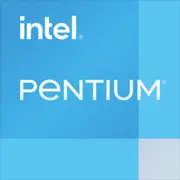Intel Pentium 2030M

Intel Pentium 2030M: A Modest Workhorse for Basic Tasks. Is it Worth Considering in 2025?
Introduction
Even in 2025, laptops with Intel Ivy Bridge processors, such as the Pentium 2030M, continue to find their users. This chip, released over ten years ago, is still seen in budget devices and in the second-hand market. But how relevant is it today? Let's break down the details.
Architecture and Technology: A Legacy from 2013
Ivy Bridge: A Step into the 22nm Era
The Pentium 2030M is built on the Ivy Bridge microarchitecture (3rd generation Intel Core). It was Intel's first 22nm process using Tri-Gate (3D) transistors, which allowed energy consumption to be reduced by 20-30% compared to its predecessors (Sandy Bridge, 32nm).
CPU and iGPU Specifications
- Cores and Threads: 2 cores, 2 threads — lacking Hyper-Threading limits multitasking.
- Frequencies: Base frequency — 2.5 GHz, turbo mode is not supported.
- iGPU: Intel HD Graphics (Ivy Bridge generation) with a base clock of 650 MHz and dynamic boosting up to 1100 MHz. It supports DirectX 11 but struggles even with simple games from the 2020s.
- Cache: 2MB L3.
Architectural Features
- Support for DDR3L-1600 (up to 32GB), but in reality, laptops rarely came with more than 8GB.
- Lack of AVX2 and other modern instruction set extensions — critical for software optimized for newer processors.
Power Consumption and TDP: Balancing Power and Battery Life
TDP 35W: What Does It Mean?
- The chip is suitable for laptops with passive or modest active cooling.
- In idle mode, power consumption drops to 5-7W thanks to SpeedStep technology.
- For comparison: modern Intel Core U-series (2025) have a TDP of 15W and superior performance.
Heat Generation
- Even under load (for example, while encoding video), temperatures rarely exceed 75°C.
- Tip: If the laptop overheats, the issue is likely dry thermal paste or a dusty radiator.
Performance: The Reality of 2025
Geekbench 6: Numbers and Reality
- Single-Core: 431 points — slightly lower than the Intel Celeron N5100 (2021, 450 points).
- Multi-Core: 720 points — equivalent to Snapdragon 8cx Gen 1 (2019).
Task Tests
1. Office Work:
- Google Docs, Excel with tables up to 10,000 rows — acceptable, but there are delays with complex formulas.
- Simultaneous work with 10+ tabs in Chrome is only feasible with 8GB of RAM and an SSD.
2. Multimedia:
- 1080p/60fps playback: No problems.
- 4K/30fps: Hangs without hardware decoding.
3. Gaming:
- Older games (CS:GO, Dota 2 on low settings): 20-30 FPS.
- Modern titles (even indie games from 2023-2024): Unplayable.
Turbo Mode: It Doesn’t Exist
A fixed frequency of 2.5 GHz makes the chip predictable but does not allow for any headroom for short bursts of load.
Use Cases: Who is the Pentium 2030M Relevant for in 2025?
1. Educational Laptops:
- School presentations, online courses, text work.
2. Office Tasks:
- Suitable for cash systems, data collection terminals.
3. Backup Devices:
- A budget laptop for travel, where the risk of loss/breakage is high.
Who It’s Not Suitable For:
- Freelancers working with graphics or video.
- Gamers.
- Users of modern OS with high requirements (e.g., Windows 11 is not officially supported).
Battery Life: How Long Will It Last?
- Laptops with the Pentium 2030M were equipped with 35-40 Wh batteries.
- In 2025, original batteries have likely degraded, but after replacement, one can expect:
- Web surfing: 4-5 hours.
- Video playback: Up to 6 hours (thanks to energy-efficient HD decoding).
Power-Saving Technologies:
- SpeedStep — dynamic frequency management.
- C-States — powering off unused CPU blocks.
Tip: For maximum battery life, disable background applications and use Linux (e.g., Lubuntu).
Comparison with Competitors: Where Pentium 2030M Falls Short?
1. AMD E2-6110 (2014):
- Similar performance but with a weaker iGPU.
2. Intel Celeron N4500 (2020):
- TDP 6W, DDR4 support, 1.5 times higher speed in single-threaded tasks.
3. Apple M1 (2020):
- Even the base M1 outperforms the Pentium 2030M by 6-8 times in multi-threaded tasks.
Conclusion: The Pentium 2030M is a relic, relevant only within a budget of $300 for a new device (e.g., brands like Trekstor or Chuwi).
Pros and Cons: Weighing the "For" and "Against"
Strengths:
- Low cost of laptops (new models — $250-$400).
- Sufficient performance for basic tasks.
- Ease of upgrade (replacing HDD with SSD, adding RAM).
Weaknesses:
- No support for Windows 11.
- Limited multi-threading capabilities.
- Outdated ports (often lacks USB-C).
Recommendations for Laptop Selection
1. Device Type:
- Budget Laptop: For example, HP 255 G8 (new, $320).
- Ultrabook: Avoid — the Pentium 2030M is not fitted for thin cases.
2. What to Look For:
- Definitely SSD: Even a 128GB SATA drive transforms the user experience.
- 8GB RAM: Minimum for 2025.
- Screen: An IPS panel — will save your eyes during long work sessions.
3. Avoid:
- HDD instead of SSD.
- 4GB RAM.
- "Gaming" models with this CPU — it's a marketing gimmick.
Final Conclusion: Who is the Pentium 2030M Suitable For?
This processor is for those who:
- Are looking for an ultra-cheap new laptop for text, email, and YouTube.
- Do not plan to use the laptop for more than 1-2 years.
- Value repairability (many components are replaceable).
Key Benefits:
- Price below $400.
- Predictable performance in simple scenarios.
- Compatibility with 2010s peripherals (VGA, DVD drives).
Alternative for 2025: If the budget allows for $500-$600, consider laptops with Intel N100 or AMD Ryzen 3 7320U — they are 3-4 times faster and support modern standards.
The Pentium 2030M is not a choice for the future, but a workable solution for here and now, where every penny counts.
Basic
CPU Specifications
Memory Specifications
GPU Specifications
Miscellaneous
Benchmarks
Compared to Other CPU
Share in social media
Or Link To Us
<a href="https://cputronic.com/cpu/intel-pentium-2030m" target="_blank">Intel Pentium 2030M</a>